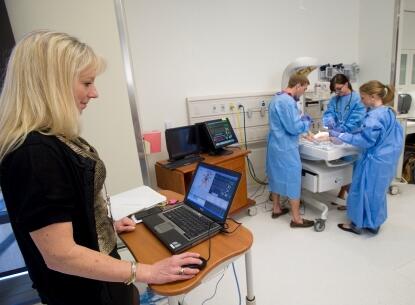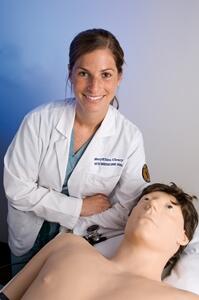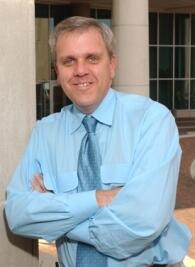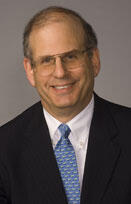
Aug. 1, 2013
Changing the way medicine is taught
VCU School of Medicine launches new curriculum with opening of building
Share this story
During MaryEllen Dolat’s first and second years of medical school at VCU, her learning experience heavily centered on lectures presented in a large auditorium, where she sat among a sea of nearly 200 other classmates.

The medical school curriculum was packed with two years of mainly lecture-based learning of the basic sciences, followed by two years of hospital-based clinical training. During those first two years, there were lots of facts to be memorized and limited opportunities to develop problem-solving skills and to transfer knowledge to clinical situations.
But this was the way medicine had always been taught. Little had changed in the more than 100 years since The Flexner Report set the gold standard for medical education in 1910 – a standard that continues in most schools today. The report, which was commissioned by the Carnegie Foundation, summarized a study of medical education in the United States and Canada authored by Abraham Flexner, a professional educator.
So when Dolat, now a second-year urology resident at VCU and a captain in the Air Force, was presented with an opportunity to take part in reshaping the medical school curriculum for future students at the Virginia Commonwealth University School of Medicine, she jumped at the chance.
As a member of the medical school’s Curriculum Council, Dolat acted as a “fly on the wall” during classes and lectures. Dolat, who graduated in 2011 from the School of Medicine, was one of more than 200 students and faculty members who took part in various committees that oversaw the curriculum renewal process to transform medical education at VCU.
| Read more: A Collaborative Approach |
As the new curriculum began to take shape, planning for a new educational facility that would allow the medical school to expand class size began to evolve. This allowed the Curriculum Council to take key components of the new curriculum and map it onto a physical space, the James W. and Frances G. McGlothlin Medical Education Center, a 12-story, 200,000-square foot building that opened this year.
“The building is a technological marvel that will allow us to do things with education both in this building and outside the building that could never have been done with our current facilities,” said Jerome F. Strauss III, M.D., Ph.D., dean of the VCU School of Medicine.

Transforming the Curriculum
The process began in 2008, when faculty and students participated in focus groups to identify what was most important in medical education.
As feedback and stories were relayed to the Curriculum Council, it became apparent that the new curriculum needed to support new types of learning, including team-based learning, individual problem-based learning and simulation.
“Adult learning theory shows that the best way to help students retain information is for them to be able to critically think, problem solve and get them excited about education so they want to continue working with it,” said Isaac K. Wood, M.D., senior associate dean for medical education and student affairs in the VCU School of Medicine, who led efforts on the development of the new curriculum.
“It’s the underpinnings of the entire curriculum – students working in teams and small groups,” he said.
Competence vs. Facts
So, how does the VCU School of Medicine curriculum differ from what has traditionally been taught?
For starters, it is competency-based, which is a trend in medical education today.
“Focusing on facts is one thing, but focusing on integration and application of knowledge is another,” Strauss said. “And that’s what our curriculum is designed to do.”
“With our School of Medicine, we’re looking for people who will improve the health of our nation, improve the health of our patients - that’s the outcome we want.”
And with that, the Curriculum Committee developed four themes they believed to be critical to the practice of medicine, including professionalism, patient care practices, integration of knowledge and evidence-based medicine. These themes have been thread through all four years of the curriculum.
“These are the skills physicians need throughout their professional life,” Strauss said.
“Instead of giving these critical components in blocks in the curriculum, they are reinforced in a linear manner and this really inspires students to retain that information, to use it in working through problems either in a classroom or at the bedside.”
Third-year medical student Tony Mazzella, who represents his peers as a member of the Curriculum Council, said that the three facets of the new curriculum that will be “especially valuable” to students will be efficiency, more small group activities and more active learning.
“The new curriculum will compress the first four semesters into three by removing redundancy of topics across classes and targeting the most important topics for a pre-clinical student to master,” Mazzella said.
“More small-group learning will encourage students to work through issues together with the theory of better retention and active learning during the first pass through a block of a material.”
Last year, Mazzella was involved in admissions and provided tours to prospective students. He hopes to help educate future campus tour guides and applicants about the changes to the curriculum.

Active Learning
The new education center’s four large learning studios enable students to work in teams so they can collaborate and learn from one another. These studios house a collection of pear-shaped collaboration tables that each seat six students. A computer monitor allows for students to work together on case studies. This concept moves away from the old-school traditional setup of a faculty member standing behind the podium and lecturing students.
The rooms are arranged with as much flexibility as possible. A hydraulic wall in the center of the room can split the standard 66-table studio into two rooms with 33 tables apiece. Mounted TV cameras aimed at each wall’s white boards can capture a team’s notes. With a computer tablet in hand, faculty members can zoom in on any team’s problem-solving efforts for the entire class to see.
“Previously, approximately 75 percent of lectures involved passive learning,” Wood said. “First- and second-year students sit in a large lecture hall with stadium seating and someone just lectures to students.
“For adults, the optimal attention span is typically about 20 minutes and after that it falls off dramatically. Yet we expect our student to sit there for hours, listen to lectures and somehow take this information in.”
Dolat added that the new curriculum will focus more on integrating material – basic science and clinical as well as multiple organ systems.
“The courses will be grouped in a way that makes sense to students – as opposed to each course being taught independent of the ones prior,” she said.
For example, Dolat took four separate courses to learn about the renal, endocrine, muckuloskeletal and cardiovascular systems. The new curriculum offers courses that will be grouped together so that topics that are interdependent – such as cardiovascular, respiratory and renal – may be taught together.
Strauss said that another innovation in the new curriculum is the longitudinal interaction between students. In addition to learning with each of their current-year classmates, students will have long-term interaction with students ahead of them in the sequence, as well as behind them.
“That sharing is important in terms of decision making, and peer support is essential for success in medicine and starts at day one,” Strauss said.
The unity offered through longitudinal interaction is made possible through the dedicated classrooms, small-group and breakout areas. Medical students, interns, residents and physicians also are afforded opportunities to interact in common areas, such as in the Student Forum on the first floor of the building.

Simulation, Patient Safety and Cross-Campus Collaboration
Several aspects of the new curriculum will help these future physicians learn to practice medicine efficiently and with empathy and caring. In addition, tremendous changes in technology have advanced the way people are able to learn.
The new building boasts approximately 25,000 square feet of simulation space, occupying two floors of the education center with state-of-the-art simulation technology.
The VCU Center for Human Simulation and Patient Safety, formerly housed in the VCU Medical Center’s North Hospital, has moved operations to the new building.
From the very first day of medical school, students will work with standardized patients. These individuals are trained to act as patients and participate in active role-playing with medical school students. The Standardized Patient Program, made possible through a unique collaboration between the VCU School of Medicine and the VCU School of the Arts, helps students learn how to effectively conduct the physicians’ traditional interview: the history and physical. They will learn how to care for the entire spectrum of the patient population – from pediatric to geriatric patients. Read more: “Medical Students Learn Art of Patient Perspective.”
Teamwork: Interprofessional Education
Interprofessional education provides students from a variety of health care professions including medicine, nursing, pharmacy, allied health and dentistry, the opportunity to work together while they are still in school, as opposed to first interacting with one another once in the hospital and caring for real patients.
“Interprofessional training is essential to improving cost of medical care,” Strauss said.
“Medicine is a team sport and the traditional medical education has not realized that. We have people learning in silos – medical students in medical schools; nursing students in nursing schools; pharmacy students in pharmacy schools and so on … These individuals need to come together at an early stage in training so they understand the value that each brings to patient care,” he said.
“Very few medical schools have the wealth of health sciences talent that is here at VCU – schools of Medicine, Pharmacy, Nursing, Allied Health Professions and Dentistry.” Read more: “A Collaborative Approach."
Subscribe for free to the weekly VCU News email newsletter at http://newsletter.news.vcu.edu/ and receive a selection of stories, videos, photos, news clips and event listings in your inbox every Thursday.
Subscribe to VCU News
Subscribe to VCU News at newsletter.vcu.edu and receive a selection of stories, videos, photos, news clips and event listings in your inbox.











